Science and the Artist's Book
An exhibition by the Smithsonian Institution Libraries and the Washington Project for the Arts
Biology
 Herald of Science
Herald of Science
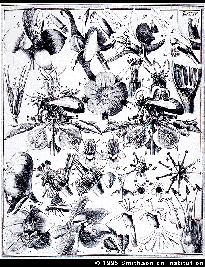 Download full-size JPEG
(455K) or GIF (249K)
image.
Download full-size JPEG
(455K) or GIF (249K)
image.
Christian Konrad Sprengel
Das entdeckte Geheimniss der Natur im Bau und in der Befruchtung der Blumen [The secret of nature in the form and
fertilization of flowers discovered]
Berlin, 1793
Christian Sprengel's 1793 treatise on floral structure
examines the ways that flower colors, scents, shapes, and
markings work harmoniously to attract insects for pollination. A
clergyman and botanist, he spent his life researching the role
played by the wind and insects in the fertilization of flowers.
Although Sprengel's work was neglected by his contemporaries,
Charles Darwin later praised Sprengel's studies.
 Artist's Book
Artist's Book
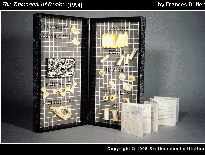 Download full-size JPEG (283K) or
GIF (175K) image.
Download full-size JPEG (283K) or
GIF (175K) image.
Frances Butler
The Taxonomy of Desire
Berkeley, California, 1994
[wood, porcelain, paint, paper]
Even scientific theories are subject to cycles of popularity.
For Frances Butler, Sprengel's system of visually grouping plants
by color, scent, and shape is returning to fashion after half a
century of disfavor. To celebrate taxonomy (the science of
classification), she presents a catalog of pasta, with all its
appeal to the appetites, organized by color, taste, and shape.
 Herald of Science
Herald of Science
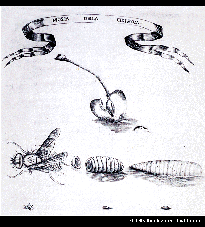 Download full-size JPEG (327K) or GIF (211K) image.
Download full-size JPEG (327K) or GIF (211K) image.
Francesco Redi
Esperienze intorno alla generazione degl'insetti
[Experiments on the generation of insects]
Florence, 1688; first published 1668
Francesco Redi, a 17th-century Italian physician, challenged
the widespread belief that flies were spontaneously generated
from decaying animal and vegetable matter. He designed an
experiment using two flasks containing meat, one tightly closed,
the other open to the air (and to flies). Only the meat in the
open flask became infested, demonstrating that the generation of
insects was not spontaneous, but caused by the laying of eggs.
 Artist's Book
Artist's Book
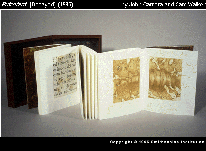 Download full-size JPEG (192K) or GIF (148K) image.
Download full-size JPEG (192K) or GIF (148K) image.
John Carrera and Sam Walker
Putrefatti [Decayed]
Cambridge, Massachusetts, 1995
[embossing, intaglio and letterpress printing on laid paper]
As the pages are turned, the text seems gradually to
deteriorate while bug-like forms appear to grow in size. In this
way, John Carrera and Sam Walker visually document the natural
processes that Redi observed in testing the idea of spontaneous
generation. The closed flask image represents the "constant" in
the experiment, while the open flask represents the "variable" that is engulfed by flies at the book's conclusion.
 Herald of Science
Herald of Science
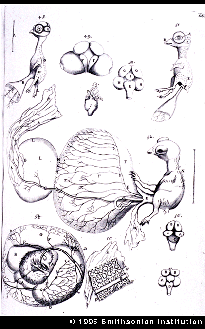 Download full-size JPEG (292K) or GIF (103K) image.
Download full-size JPEG (292K) or GIF (103K) image.
Marcello Malpighi
Anatome Plantarum [On the anatomy of plants]
London, 1675
Malpighi launched the microscopic analysis of plant anatomy as
a scientific field of study. He also cataloged the similarities
between the growth stages of plant and animal embryos. In Anatome
Plantarum, he presented many images of plant cells drawn from
seeds, stalks, and cross-sections of wood. Malpighi taught at the
University of Bologna and was physician to Pope Innocent XII.
 Artist's Book
Artist's Book
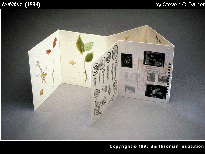 Download full-size JPEG (272K) or GIF (148K) image.
Download full-size JPEG (272K) or GIF (148K) image.
Steven C. Daiber
Untitled
Williamsburg, Massachusetts, 1994
[woodcuts, watercolor, photocopies]
Steven C. Daiber, the son of two biologists, investigates
forms of nature through his drawings. He responds to Malpighi's
pioneering book in a very personal way, relating images of plant
growth to vegetation found near his Massachusetts home, and
comparing chicken embryo stages to the pre-natal sonograms of his
daughter.
 Herald of Science
Herald of Science
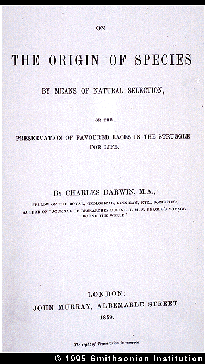 Download full-size JPEG (376K) or GIF (140K) image.
Download full-size JPEG (376K) or GIF (140K) image.
Charles Robert Darwin
On the Origin of Species by Means of Natural Selection
London, 1859
Charles Darwin, a naturalist on board H.M.S. Beagle during its surveying voyage around the world (1831-1836), collected many plant and animal specimens. Back in England, Darwin studied these specimens and accounted for their variations by theorizing that species continued to evolve over time. Later, experimenting with the cross-pollination of flowers in his garden, he noted that human intervention in the cultivation of plants worked much like natural selection, helping to perpetuate the most desirable or vigorous traits in each species.
 Artist's Book
Artist's Book
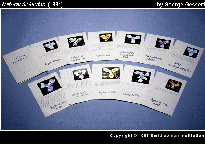 Download full-size JPEG (274K) or GIF (132K) image.
Download full-size JPEG (274K) or GIF (132K) image.
George Gessert
Natural Selection
Eugene, Oregon, 1994
[computer-printed handwriting, paper, inks, Cibachrome prints]
In his artist's book, George Gessert takes inspiration from
his experiments hybridizing irises. He selects his plants based
on their aesthetic qualities and contends that Darwin also
recognized aesthetics as an evolutionary factor. Gessert's view
is based on the first chapter of On the Origin of Species,
in which Darwin discusses the breeding of pigeons for their
ornamental characteristics.
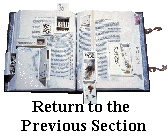

 Herald of Science
Herald of Science
 Herald of Science
Herald of Science
 Download full-size JPEG
(455K) or GIF (249K)
image.
Download full-size JPEG
(455K) or GIF (249K)
image.
 Artist's Book
Artist's Book
 Download full-size JPEG (283K) or
GIF (175K) image.
Download full-size JPEG (283K) or
GIF (175K) image.
 Herald of Science
Herald of Science
 Download full-size JPEG (327K) or GIF (211K) image.
Download full-size JPEG (327K) or GIF (211K) image.
 Artist's Book
Artist's Book
 Download full-size JPEG (192K) or GIF (148K) image.
Download full-size JPEG (192K) or GIF (148K) image.
 Herald of Science
Herald of Science
 Download full-size JPEG (292K) or GIF (103K) image.
Download full-size JPEG (292K) or GIF (103K) image.
 Artist's Book
Artist's Book
 Download full-size JPEG (272K) or GIF (148K) image.
Download full-size JPEG (272K) or GIF (148K) image.
 Herald of Science
Herald of Science
 Download full-size JPEG (376K) or GIF (140K) image.
Download full-size JPEG (376K) or GIF (140K) image.
 Artist's Book
Artist's Book
 Download full-size JPEG (274K) or GIF (132K) image.
Download full-size JPEG (274K) or GIF (132K) image.

